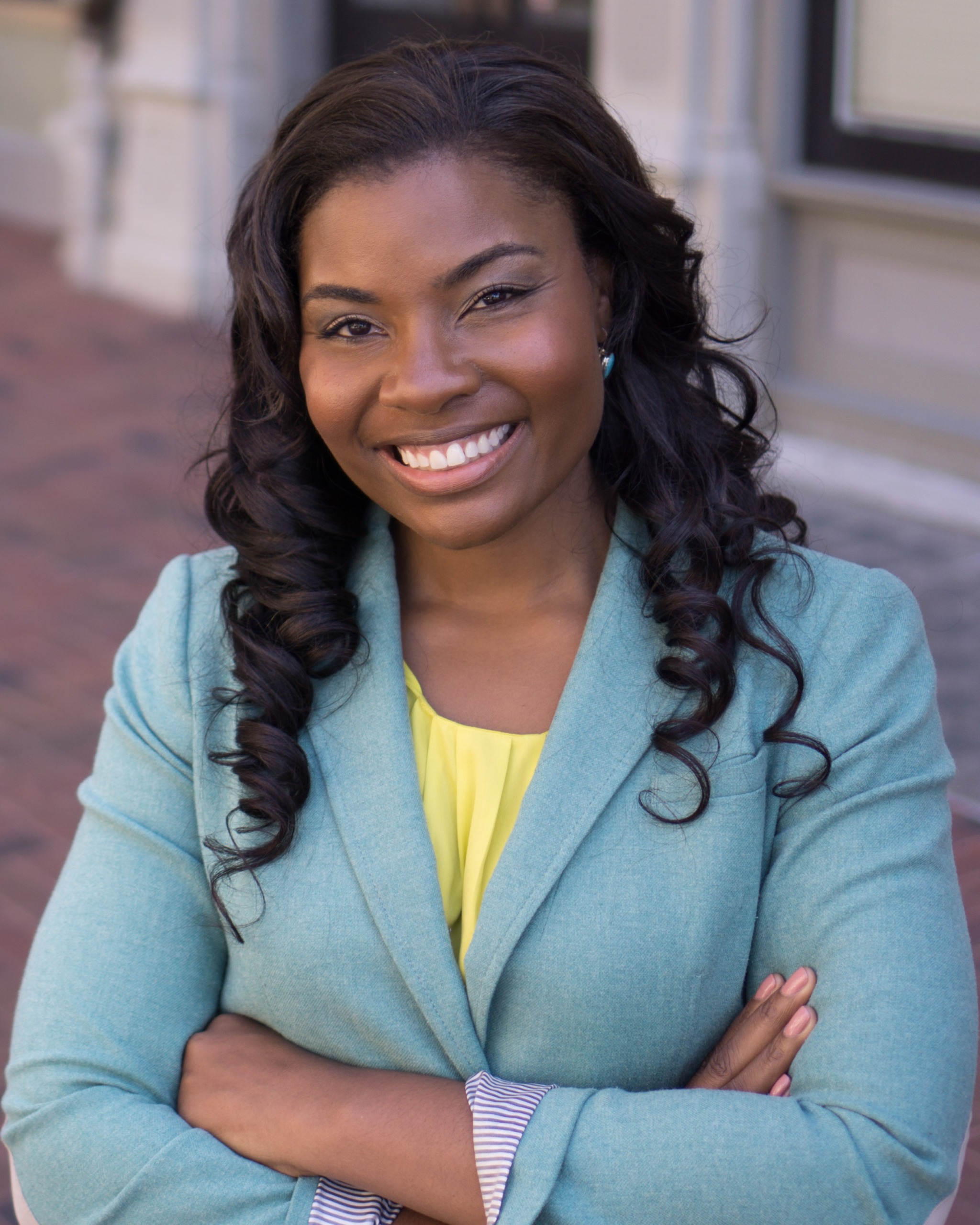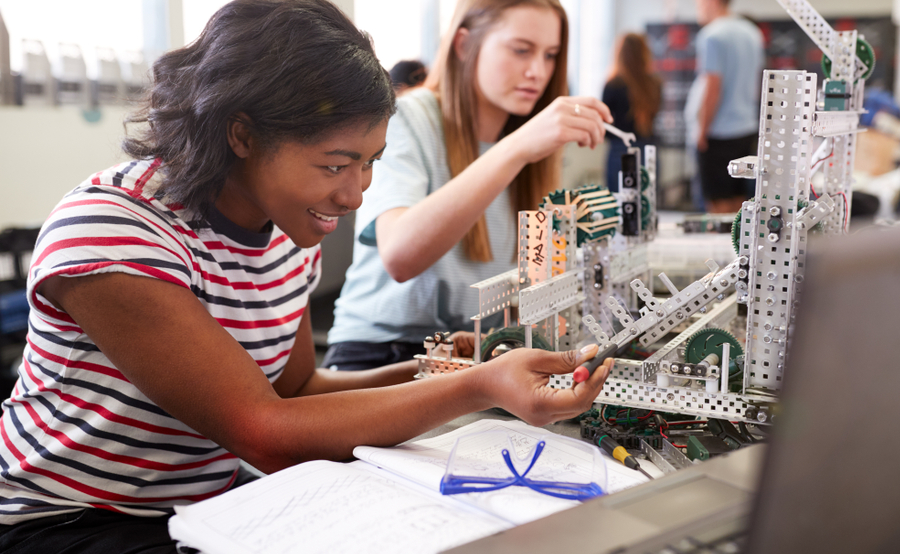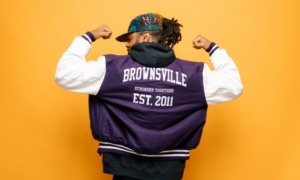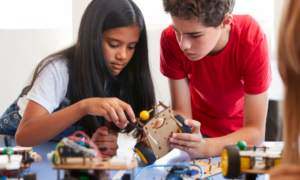For too long, girls of color, especially Black and Latina girls, have been asked to show up and persist in STEM places that don’t create a sense of belonging. While Black girls demonstrate an interest and excitement about math and science, research shows that it is STEM gatekeepers who dim a girls’ light during their STEM journey. STEM gatekeepers represent a source of power and influence that has important implications for antiracism, diversity, equity, and inclusion-related outcomes in STEM environments and they are often people who are unaware of their individual biases.

Courtesy of Techbridge Girls
Nikole Collins-Puri
The educators – namely teachers, youth workers and volunteers – in the room make the difference. A recent unCommission study by Beyond100K noted the power of educators, finding that 40% of its storytellers, young people between the age of 13-29, identified an oftentimes singular experience with a STEM educator that shifted their sense of belonging in STEM, even after previously believing they did not. Storytellers in the study represented a median age of 21 and 82% were Black, Latina/X and Indigenous.
This research indicates that self-perception around STEM is very much changeable, and STEM educators are uniquely positioned to center Black, Latina/x and Indigenous girls’ STEM stories, contributions and experiences.
As the growing demand to expand belonging in STEM for girls increases, it is crucial to implement strategies that focus on the systems, practices and policies that impact the ability to improve representation and sustain access to a diverse and inclusive STEM workforce.
Recent federal STEM equity initiatives are driving a shift in the emphasis, but there is still work to be done.
Reimagining a STEM pathway where BIPOC girls belong, persist and thrive means answering questions like what are BIPOC girls being asked to belong to? Are these spaces made with their experiences, trailblazers, innovators, backgrounds, voices and intersectional identities in mind?
Answers to these questions can be gathered by offering gatekeepers an equity-centered road map rooted in three pillars — being STEM, doing STEM and using STEM.
Being STEM means girls need to experience culturally relevant and gender-responsive STEM education to truly feel a sense of belonging. A 2022 study released by the Bill and Melinda Gates Foundation found that when asked what K-12 math education should ideally be like, the survey respondents , which included U.S. parents, teachers and adults, were most likely to say “relevant to the real world” and “useful.” For Black, Latina/x and Indigenous girls to engage in STEM as an activity, passion or profession, they must first recognize that they are part of a long history of major contributors to the field. The stories of the discoveries and contributions of women of color to STEM have been erased from history books, leaving society with written and visual depictions that the STEM community has been historically led and advanced by white men. Since today’s educators were trained in that same structure, they must reimagine STEM spaces where youth experiences are centered and students can be supported in all aspects of their identities. Then they can allow girls to choose the skills they want to learn and give them resources on how to apply them.
Doing STEM means creating hands-on STEM in girls’ own language which supports exploration, innovation and the development of can-do beliefs. All great discoveries were built upon many practiced and failed experiences, yet the education system continues to prioritize rote learning. That creates a disconnect for students on how STEM can be applied to everyday life and nurture creativity. Educators trained to use the engineer design process (EDP) can encourage brainstorming, collaboration and iteration as girls learn to design and test different STEM solutions that impact real-world problems. This approach enables educators to foster a supportive environment where youth combine their inherent creativity and STEM learning.
Using STEM means that without BIPOC girl genius, STEM solutions won’t address or solve the most pressing issues for social change. As global issues mount, it has become even more evident that there is a growing need for creative minds to solve real-world problems. STEM education is a tangible way to create a more just society through both empowering girls of color and demonstrating a real impact on their communities. This is evidenced throughresearch like that of Algorithmic Justice League’s Joy Buolamwini who exposed the skin type and gender bias in commercial AI products, which led to a global discussion on issues of algorithmic bias.
Ultimately, STEM stories, spaces and pedagogical approaches need to be reimagined and cultivated so that Black and brown girls can have a sense of belonging and thrive in their STEM aspirations.
Through collective partnerships like that of Beyond100K, #GirlsLeadSTEM coalition and over a hundred Techbridge Girls partners across the country, evidence of equitable STEM education is being seen and realized. For Beyond100K, this has equated to uniting leading STEM organizations to work together, share knowledge, and co-create solutions to prepare 150,000 and retain 150,000 excellent STEM teachers over the next decade. These teachers will reflect the diversity of the nation’s classrooms and create inclusive and welcoming environments in schools and classrooms, particularly in Black, Latinx, and Native American communities. But there is so much more work to do.
Educators — in classrooms, afterschool programs and in the community — have the power to show girls that they are celebrated, centered and belong 365 days of the year. There is a collective power to reimagine a STEM pathway that works for every girl, no matter what they look like or where they come from. But first we must fling open the gates so the genius can flow through.
***
Nikole Collins-Puri serves as CEO of Techbridge Girls, a national nonprofit organization re-engineering STEM education for Black, Indigenous, Latina girls and gender-expansive youth by equipping out-of-school time educators and STEM professionals with gender-responsive, culturally relevant curriculum and equity training.






























